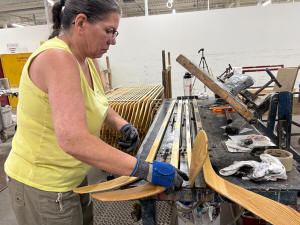Canada's last hockey stick factory survives in face of tariff threats
and globalization
[October 07, 2025] By
KELVIN CHAN
BRANTFORD, Ontario (AP) — Wearing protective gloves and earplugs, a
worker feeds lengths of wood into a machine that makes an earsplitting
whine as it automatically cuts a groove into the end of each piece.
Nearby, stacks of wooden wedges wait to be slotted into those grooves to
form the beginnings of a hockey stick. Further down the Roustan Hockey
production line, other workers are busy shaping, trimming, sanding,
painting and screen printing as they turn lumber into a Canadian
national symbol.
It's a typical day on the job for the 15 workers at Canada's last major
hockey stick factory, 60 miles (100 kilometers) southwest of Toronto.
The operation has origins that date back to the 1800s and has survived
decades of trade globalization to hang on as the last North American
commercial manufacturer of traditional wooden hockey sticks. Now it's
facing fresh headwinds from the trade war launched by U.S. President
Donald Trump, who has ripped up free trade deals in North America and
imposed tariffs on Canadian exports.
The uncertainty is making life a headache for Roustan.
“You never know” what Trump will do, said Bo Crawford, the factory's
general manager. “You just have to roll with it and the president of the
U.S. can change his mind day to day, week to week, hour to hour. So
yeah, we have to deal with it the best we can," he said.
Roustan has spent months dealing with U.S. customer worries and
navigating the trade challenges.
Trump has repeatedly threatened to impose tariffs on Canadian imports,
though many goods have ultimately remained exempted because they're
already covered by the U.S.-Mexico-Canada Agreement negotiated during
his first term.

Then, in late August, the Trump administration eliminated a widely used
customs exemption for international shipments worth $800 that resulted
in new uncertainty over cross-border trade, said owner and CEO Graeme
Roustan.
“Even if somebody buys one or two or five or 10 sticks and it’s under
$100, they’re going to be affected by the tariffs, so the jury is still
out on how that’s going to impact business,” Roustan said.
Roustan Hockey's factory churns out about 400,000 wooden hockey sticks a
year under the Christian, Northland and Sherwood brands, with about
100,000 exported to the United States. It also makes plastic-bladed road
hockey sticks and foam-core goalie sticks.
Crawford said shipments to the U.S. have been held up for manual
inspections at the border, where they've been hit with surprise tariffs,
which the company's customs broker has managed to get waived.
It's not just sticks. Shipments of goalie pads, which Roustan
manufactures at a separate factory in Toronto, were recently flagged for
an unexpected 200% tariff, which company managers said they're trying to
resolve with new forms from their shipping company.
The disruption underscores the broader trade turmoil that's left the
Canadian economy reeling.
Canada's economy shrank 1.6% in the second quarter, in the first
contraction since 2023 and the biggest decline since the COVID-19
pandemic. Exports slumped 7.5%, as uncertainty over tariffs and trade
pummeled exports to the country's biggest trading partner, the United
States.
Those figures overshadow the longer-term decline of Canadian
manufacturing. Some 37,800 manufacturing jobs were lost in the year to
August, according to official data.
Real investment in industrial machinery and equipment fell in the second
quarter to the lowest level since records began in 1981, experts at the
National Bank of Canada pointed out in a recent research note.

[to top of second column] |

A worker makes wooden hockey sticks at the Roustan Hockey factory,
which is the last major manufacturer of hockey sticks in Canada on
Aug. 27, 2025 in Brantford, Ontario. (AP Photo/Kelvin Chan)
 “How did we get here? Years of
excessive regulation, and a chronic lack of ambition by successive
governments in promoting domestic transformation of our natural
resources—recently made worse by Washington’s protectionist agenda,”
wrote economists Stéfane Marion and Matthieu Arseneau. "That failure
has eroded Canada’s manufacturing base and left us at risk of
becoming irrelevant in global supply chains.”
The Roustan operation started life in 1847 as an agricultural
workshop, 20 years before Canada became a country and 70 years
before the National Hockey League was created.
It's all that survives of the golden era of North American wooden
hockey stick manufacturing in the 1970s and ’80s when there were
numerous workshops in Ontario and Quebec, as well as U.S. production
centered in Minnesota.
Roustan, a businessman who also owns The Hockey News and once
attempted to buy the Montreal Canadiens, acquired the operation in
2019 — by then named Heritage Wood Specialties — and moved it from
aging facilities in the town of Hespeler, 20 miles (30 kilometers)
north of Brantford, hometown of hockey legend Wayne Gretzky.
Nowadays, global production amounts to about 5 million hockey sticks
a year, but wood makes up only about a tenth. No NHL player has
regularly used a wooden stick in well over a decade, underlining the
sport's embrace of newer technology.
Composite sticks, made of carbon fiber and other lightweight
advanced materials, are now far more popular and preferred by both
amateurs and professionals. But composite sticks are pricier because
of the advanced manufacturing processes involved.
Meanwhile, over the years, Canadian and U.S. production consolidated
or moved to Asia and Mexico amid a wider global shift by Western
consumer brands in search of cheaper manufacturing overseas.
“It’s very hard to compete against some of the Asian markets and
some of our competitors that are in other countries," said Crawford.
“But our quality kind of stands for itself.”
Roustan acknowledges that the wooden hockey stick market is not a
growth industry and, at best, production will hold steady.

“Right now, we have, you know, 5-10% of the market. But it’s
diminishing every year. And the kids that are growing up today, they
are all about composite. So yes, it’s a shrinking market for sure.”
At Roustan's 130,000 square foot factory, the manufacturing process
is low-tech and artisanal.
At one workstation, a worker uses liquid epoxy to glue fiberglass
reinforcing sheets to wooden blades, in batches of six. Nearby,
another worker uses a band saw to trim dried excess fiberglass off
each blade. In the paint room, sticks are dipped in white paint and
then hung on a line of moving hooks to dry.
The factory's story is not just about evolving trade patterns and
modern industrial practices, but also about the place that the
national winter sport has in the Canadian soul, Roustan said.
“It’s important to any country to have a manufacturing base of
products that you consume on a regular basis,” said Roustan. “Having
a factory that makes hockey sticks in Canada really serves two
purposes. One, it contributes to the manufacturing base. But two,
(it) has the legacy and the tug of the heartstrings of the game that
we all love in Canada.”
All contents © copyright 2025 Associated Press. All rights reserved |